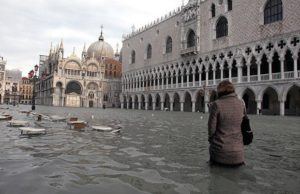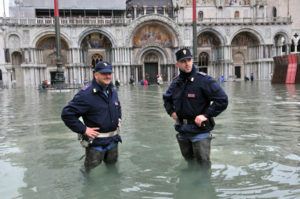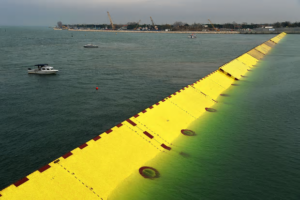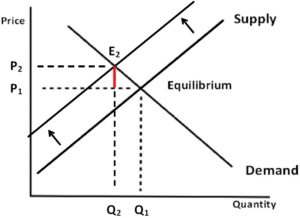Venice – the risk of the disappearance of an entire city

Cruise lines in Venice are a shocking example of how companies adapted their business model to exacerbate the effects of climate change and thereby contribute to the risk of the disappearance of an entire city.
Venice, a UNESCO world heritage site, which is known throughout the world for its beautiful lagoons, architectural sights, its city structure built on wood piles, its 118 small islands and 338 bridges[1] is under serious risk of disappearing, due to the climate change. Venice sunk 9 inches in the last century and is expected to sink another 24 inches by the end of this century.1 At the time of Venice’s founding, sea levels were almost six feet below what they are today.[2] The average number of floods per year increased from ~10 in 1900 to ~100 today[3]. The rising sea level has already damaged 100s of buildings and monuments in Venice and destroyed the marble and mosaics of multiple basilica.
One would assume that the tourism industry would take all required actions to preserve Venice as much as possible, but instead it reacted in the exact opposite way. It increased its offering to Venice, by promoting the fact, that no one knows how long Venice will be around. Between 1990 and 2011 the number of visitors increased by a factor of nine (from 0.2 to 1.8 million tourists a year)[4]. As a matter of fact, the Cruise Lines International Association (CLIA), has not reacted to any warnings or requests by the City of Venice or the Venetian population to reduce the number of ships that enter Venice every year (ca. 600 ships)[5]. The cruise ships exacerbate the problems that Venice is facing, due to dredging requirements and the movement of large ships through the Giudecca canal. The number of tourists as well as the fear of the disappearance of Venice has led to the fact that the resident population has decreased from 120,000 to 55,000 inhabitants over the past 30 years[6]. The number of tourists per day in the peak season is 5,000 people more than the entire population (60k vs. 55k)[7].
Linking all of this back to the question of how companies have adjusted their business and operating model to address the climate change, it becomes apparent that the tourism companies and in particular the cruise lines have taken converse actions. Without pinpointing to an individual cruise company (the biggest ones are Uniworld, MSC Cruises and Costa), the entire industry and especially the Cruise Lines International Association (CLIA) have failed to take corrective actions. They have changed their business and operating model as such to increase demand as much as possible (by exploiting the effects of the climate change), in order to maximize their short-term profits. They are thereby ignoring the negative externalities they are imposing on the entire city of Venice.
How should they react? Rather than individual companies taking corrective actions, the CLIA should take actions to help to preserve Venice (and hence ensure that tourists can visit Venice as long as possible). Despite multiple funding requests, the CLIA or any other tourist organization have not helped to fund measures to alleviate the problem. The most important project right now is the Project MOSE (Modulo Sperimentale Elettromeccanico), a $6bn barrier to protect Venice against the flood. MOSE is financed by the Italian government and is expected to protect Venice from floods of up to 9.8 feet[8].
Given that this is already in place, the CLIA should force the other cruise companies to change their business and operating model from exploiting and essentially destroying Venice, to help protecting it. In particular, it could establish a maximum quota of ships arriving per year. Due to this there will be an (artificial) shortage of supply, which will in turn shift the supply curve inwards. Prices will increase as a result. The line in red displays the additional price that can be charged (difference between P2 and P1). This price differential should be used to help preserve Venice and start concrete projects to fight against the effect of climate change.
In addition, cruise companies have to start using more remote ports to get visitors into the city. As Professor Paul Linden points out “Dredging to allow the passage of cruise liners stirs up sediment polluted by industry. The local ecosystems are under threat and this will be exacerbated if rising sea levels increase the salinity of the Lagoon”[9]
The cruise companies in the City of Venice is an example of how companies have not only failed to react to the climate change, but have even worsened the effects by adapting their business and operating model in a way to exploit these effects.
(778 words)
[1] https://www.wmf.org/project/venice
[2] http://www.pbs.org/wgbh/nova/tech/saving-venice.html
[3] http://www.livescience.com/19195-venice-sinking-slowly.html
[4] UNESCO and UNEP. World Heritage and Tourism in a Climate Change, 2016
[5] http://www.forbes.com/sites/ceciliarodriguez/2016/09/29/venice-is-fed-up-with-cruise-ships-and-angry-protesters-are-blocking-them/#5a830f946943
[6] UNESCO and UNEP. World Heritage and Tourism in a Climate Change, 2016
[7] http://www.forbes.com/sites/ceciliarodriguez/2016/09/29/venice-is-fed-up-with-cruise-ships-and-angry-protesters-are-blocking-them/#5a830f946943
[8] http://climatestore.com/blog/will-cities-venice-sea-level-rise-from-effects-of-climate-change/







I must ask, are cruise ships really that responsible for Venice sinking? I question the impact of reducing supply of cruises to Venice and the impact it may have on Venice’s problems in general. As global warming continues worldwide, Venice will continue to be submerged, regardless of cruising. Would the cruise ship industry be better suited to make a more conscientious effort to help curb the impact of global warming in a worldwide effort (e.g. more green ships)? This may need to be done in parallel with changing supply, but simply cutting supply may not be enough.
I do not believe that the article is stating that cruise ships are the sole responsibility for the sinking of Venice, just a contributor to the overall problem. In relation to the impact that cruise ships are having on the well-being of Venice, however, I find it interesting to see how these companies have taken an opposite, negative response to the sinking problem of Venice. Because Venice is such a popular tourist destination, it seems as if these cruise lines would want to preserve the city for as long as possible in order to continue squeezing tourist dollars. Are these cruise lines aware of their impact on the environment in Venice? I agree that setting a quota for the number of ships arriving each year could help alleviate the impact that cruise lines are having on the flooding. Customers may respond negatively with the lack of options in travel dates, but if cruise lines are transparent about their business decision to limit travel dates in an effort to preserve the beauty of Venice, I think that customers will accept this honesty and modify their travel behavior accordingly.
This was a fascinating read. I am appalled to hear that cruise lines have exploited the negative impact of climate change on Venice for near-term gains without consideration for long-term consequences. I agree that limiting the travel options or restricting the number of ships makes sense as a viable way to constrict supply, charge higher prices, and fund necessary preventative measures. Or, the government could also levy a tax on all cruise operators. I think it’s fantastic that MOSE is in place and will protect Venice from floods to a degree, but the further regulatory interventions you suggest make a great deal of sense.
Great post. What I find most interesting about this post is how controversial this topic is in Venice. While it seems obvious after reading this post that cruise ships are threatening the city and should be prevented from entering the beautiful canals, the topic is hotly debated in Venice and bans on ships have been proposed and overturned in recent years. While the cruise ships may cause flooding of the city and damage to historic landmarks, the tourism industry economically sustains the city. Using money generated by the tourism industry, the city is able to maintain buildings and invest in infrastructure. While it could be argued that the cruise ships are causing the very damage that must be remedied, Scott brings up the interesting point that Venice is facing issues of rising sea levels that will persist whether the cruise ships enter the canals or not. How will Venice deal with these issues if they are starved of cruise-related income?
The Venitian mayor himself opposes the ban on cruise ships, stating that such a ban would threaten thousands of local jobs. See generally, “Giant cruise ships ‘crushing the life’ out of Venice,” The Telegraph. The post raises an important question of how companies, and cities alike, need to strike a balance between economic and environmental sustainability. How should Venice position itself to survive in the short-term? In the long-term? How can companies, like cruise liners, enter into dialogue with partners, like Venice, to balance these competing interests?
This was a really interesting post about a city that, if it sinks, will take so much history and culture along with it. It gets at the heart of one of the biggest barriers to impactful environmental change – companies and communities are not focused on long-term viability but instead make decisions for near-term profitability and gain. Both cruise ships and the Venetian community have much to gain financially from allowing the ships and the tourists that they carry to continue to visit. You bring up a very interesting point in that the threat of extinction due to rising sea levels may even be fueling tourist interest in travelling to the region. If this is true, ships have even more incentive (in the short run) to continue to exacerbate the problem so that tourists are compelled to action before it’s too late. It does appear, at least, that some locals are attempting to take a stand against the cruise lines (and the government that continues to allow them in). In September 2016, “activists in gondolas and other small boats set up camp in the Venetian lagoon” in an attempt to block incoming ships. [1] It would be very interesting to further research local thoughts on the tradeoff between environmental preservation and the economic impact of reduced tourism.
[1] Marcus, Lilit, “Venice Locals Protest Cruise Ships In Their Port,” http://www.cntraveler.com/story/venice-locals-want-cruise-ships-to-skip-their-port, accessed November 2016.
This was a very interesting post and the thing that surprised me the most was that none of the top cruise lines in the world that go through the Mediterranean have on their websites any section regarding corporate responsibility or sustainability. This only underscores the accuracy of your post and your arguments that there is a significant problem, not only in Venice but in the entire industry. I agree that having a city which basically continues to thrive economically due to the Tourism industry will have a hard time to promote policies that reduce the intensity of the touristic activities. Nevertheless, I think that the only way the Tourism industry’s interests and the environment’s priorities can ever coexist is if there was still a scenario where Venice wouldn’t be doomed to disappear by rising sea levels. This would be the only way the Tourism industry will be interested in investing for its sustainability, otherwise, it would just continue to do what is doing today, increasing prices and extracting as much revenue as possible while it still can.
I find this post so interesting because I believe the situation faced by the city of Venice and the cruise companies can be extrapolated to many other industries, geographies, and companies that are facing similar internal conflicts. As you state in your article, you would think it would be in the company’s long-term best interest to want to preserve Venice, ensuring the ability to operate and derive revenue from the city into the future. However, as is the case with many other companies, it can be difficult to incentivize long-term behavior when the future is never guaranteed, and the ability to increase revenue in the short-term from this marketing campaign seems all but guaranteed.
Also, it highlights the difficulties facing government as they look to regulate corporations and the impacts they have on their geographies and populations. With Venice deriving such a high percentage of its revenues from tourists coming from the cruise ships that are exacerbating this problem, what would be the government’s incentive to mitigate tourism? While we grapple with the increasing effects of climate change today, it is still very much viewed as tomorrow’s problem — therefore, how do you incentivize today’s government to take what could be a dramatic financial hit when it could easily kick the can down the road and view it as the next generation’s problem?
Charlotte – great post! Venice is one of my favorite cities and therefore it was hard to read this post and accept what is happening there. The flood statistic (~10 to ~100) is fascinating. 10-fold in just over a century! I am also saddened by the inaction taken by the cruise ships, yet understand why they are acting in the way that they are. As we’ve seen in so many classes thus far at HBS, misaligned incentives are at the heart of so many problems. The cruise ships are able to leverage Venice’s “scarcity factor” in order to boost their own profits in the near term, and leading to the destruction of the city in the long term. I suggest we plan a visit ASAP? No cruise ships though 🙂
Great post! I do however wonder if restricting cruise ship access is the right approach to take here? This is especially true given Venice’s dependence on tourism. Instead, perhaps the Venetian government could consider a tax on cruise ships who do decide to enter, with tax revenue raised going towards Project MOSE. This way cruise ships who do enter can directly contribute to the efforts to save Venice. Venice could impose a similar tax on tourists entering the city. Personally, I would be happy to pay a tax to go back to Venice as a contribution to save one of my favorite places.
This is a fascinating post. What struck me the most was the fact that instead of trying to preserve Venice for the future generation, people decided to all visit Venice before it disappears. For me, this raises a problem of a significant mismatch of a long-term vs. short-term interest for people involved. This goes beyond just Venice. For example, Maldives is experiencing the same thing. A third party entity, e.g., the government and/or UNESCO should play an active role in managing and maintaining these climate-sensitive tourist sites.
I also very enjoy your analysis on using the business mindset to solve the problem. Using the surge in price to finance for a long-term solution is a stroke of genius. As long as they could figure out the optimal price point to maximize overall profit, this would be a great settlement to the issue as it would both reduces the number of cruises and finance the floodgate.